He was mesmerized, entranced, captivated by Kurt Vonnegut Jr’s Novel “Breakfast of Champions”. He didn’t look up. His focus never broke for the one hour plus ride during which we shared a train carriage with him. He never reached for his cell phone. Not once. Chapeau, young man!

We were on a train from Melbourne CBD to Lilydale in the Yarra valley when I noticed our avid reader.

Our objective was a visit to the Healesville Sanctuary, a facility of Zoo Victoria dedicated to the rescue and conservation of Australian species. The train line ends in Lilydale, where you take a succession of two buses to the sanctuary outside of Healesville. Depending on the swiftness of connections, it’s a 2 to 2.5 hrs trip. Since both the train and the buses are part of the Melbourne public transportation system, the roughly 5-hour roundtrip cost us less than AU$13 per person!
The Healesville Sanctuary is quite different from the city zoo as it focuses exclusively on the preservation of Australian wildlife. In addition to caring for the health of all the sanctuary animals, the veterinary office treats about 2000 injured, sick, abandoned, confiscated, or orphaned wild critters per year that are brought in by the general public or customs officials. The widespread terrain of the sanctuary is maintained as bushland with meandering paths for visitors. This natural landscaping with indigenous flora enhances the all-Australian feel of the sanctuary, not least through the ever-present gum trees and evergreens of the southern hemisphere.
My first stop was a visit with three lovely echidna ladies. Echidnas, named after the half-woman & half-snake “She-Viper” of Greek mythology, are members of the order of Monotremata, egg-laying mammals. In Australia, one only encounters the short-beaked echidna, Tachyglossus aculeatus, Tachyglossidae. Their long-beaked sisters are endemic to New Guinea. Together with the amazing [duck-billed] platypus, Ornithorhynchus anatinus, Ornithorhynchidae, these are the only surviving egg-laying mammals on earth.

Australian echidnas like to eat insects, especially ants and termites that don’t exude toxic substances, but also beetle larvae and other soft squishy invertebrates which are small enough to fit in their mouth opening of only 5 mm, then to be crushed between tongue and palate.

There’s that quick tongue which gave the echidnas the family designation Tachyglossidae “speedy-tongued”. This sticky and agile tongue is about 18 cm long and an echidna can extend and retract its tongue up to a hundred times a minute to gobble up insects. Speedy indeed! The sanctuary feeds a protein paste to the echidnas which is precisely balanced for each animal’s need. Their youngest echidna gets extra rations because she was only recently rescued from a situation in which she was kept as a pet and nearly starved to death. The people who took her from the wild had no idea what she needed nutritionally and tried to raise her on cat food. In the wild, stubby-legged echidnas roam widely in search of high-protein ants or termites.
Since echidnas are highly specialized mammals with many unusual anatomical and physiological features, I have linked a wiki report HERE. I find all these details quite fascinating!
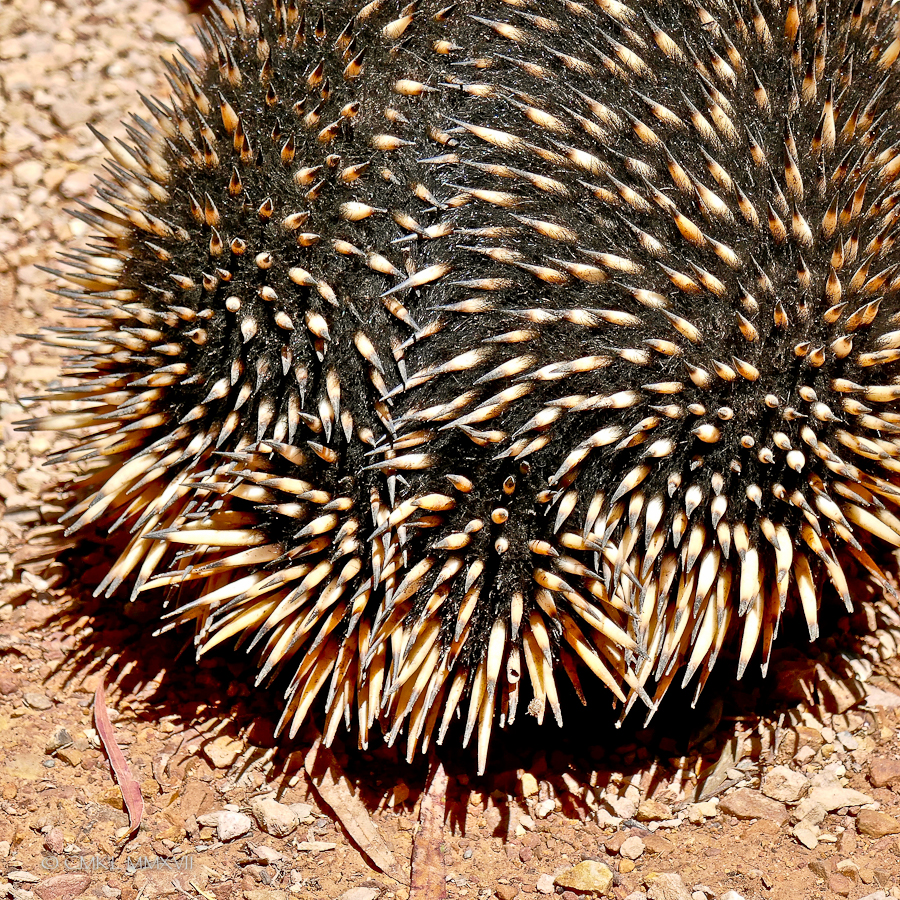
From the echidna encounter, we went in search of kangaroos.



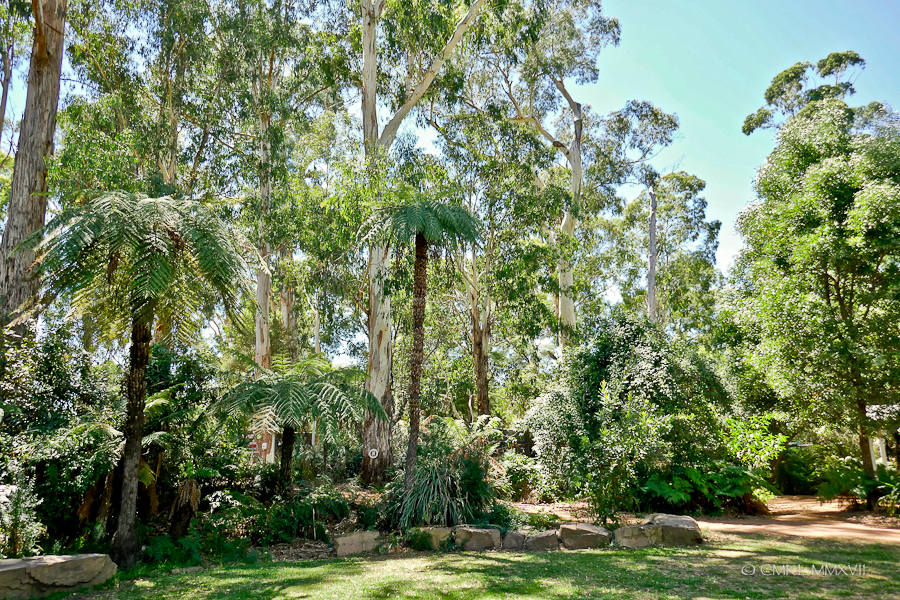
This is all part of a vast kangaroo enclosure. There aren’t any fences separating visitors from residents. It’s their home and human guests have to abide by rules and regulations of appropriate behavior.

On route to the wallabies, we met a few emus, Dromaius novaehollandiae, Dromaiidae.
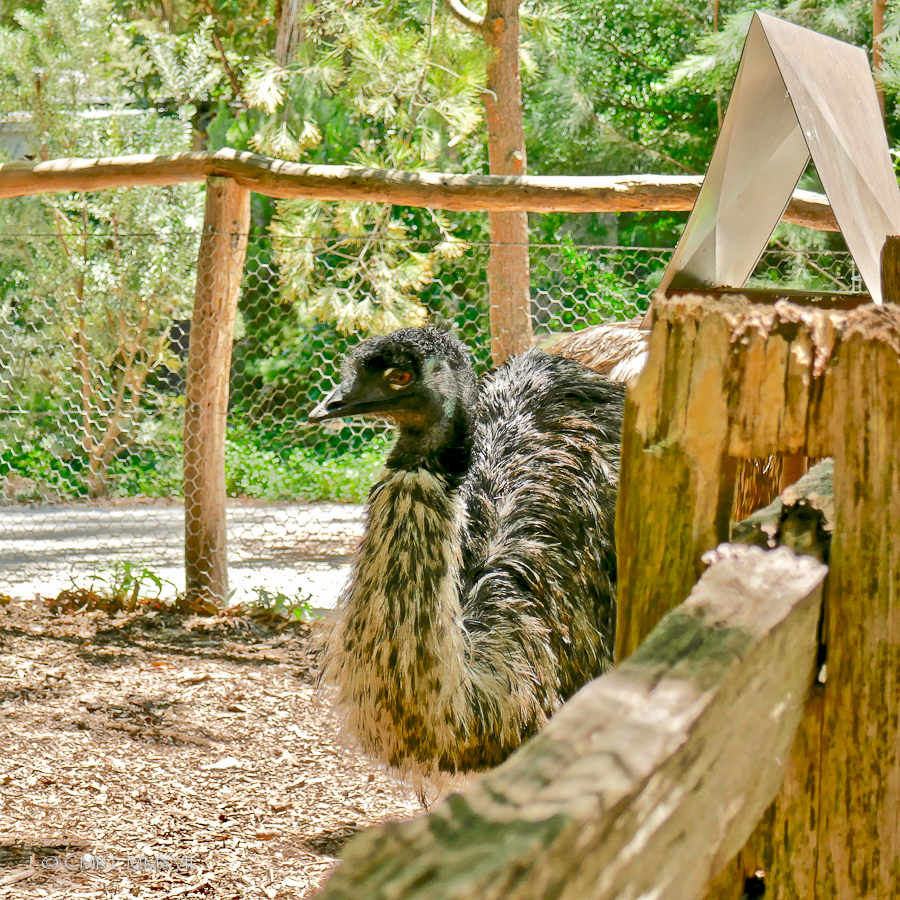
The wallabies at the sanctuary, similar to the kangaroos, have a very large enclosure without fencing separating mammals from marsupials. People have to stick to designated walkways, wallabies hop wherever they want. The term “wallaby” isn’t a biological classification, rather a casual term to separate small members of the kangaroo family from larger cousins. All “kangaroos”, “wallaroos”, and “wallabies” belong to the polyphyletic family of Macropodes, meaning bigfoot.

These rock wallabies are becoming endangered in some areas. The Healesville Sancturay was recently able to successfully release several animals from their breeding program back into the wild.

Scatteres throughout the sanctuary, you’ll find aviaries with indigenous birds, many of which are on the endangered species list. Not so the cockatiels, Nymphicus hollandicus, Cacatuidae, you see below. After the parakeet or budgie, they are the most beloved pet birds worldwide. Also seen below are two color variants of the ever popular Australian Gouldian finch, Erythrura gouldiae, Estrildidae. Gouldian finches are in decline and have been listed as endangered in the wild. There are conservations programs in place to try to repopulate their habitats.
In the image with the gnarly branches full of sleeping birdies, we see, from left to right, a male turquoise parrot, Neophema pulchella, Psittaculidae, with his lady friend to his right, followed by [I believe] one of the critically endangered Tasmanian swift parrots, Lathamus discolor, Psittaculidae; next we have a couple of Gouldian finches and lastly two cockatiels. It was unfortunately very difficult to pick up any detail of these beautiful birds because all shots were by necessity directed from a dim interior against bright light.
The birds below, however, were lounging in bright sunshine, but very far away. Can’t win, can you? Meet a few more of Barry’s beloved Australian pelicans, Pelecanus conspicillatus, Pelecanidae:

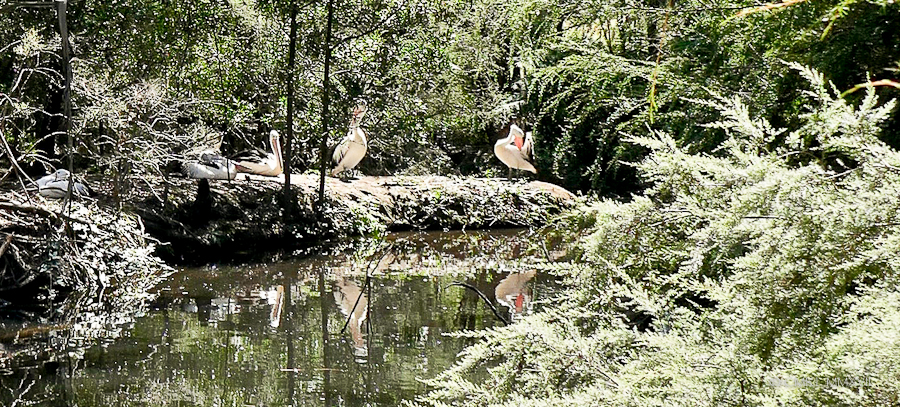
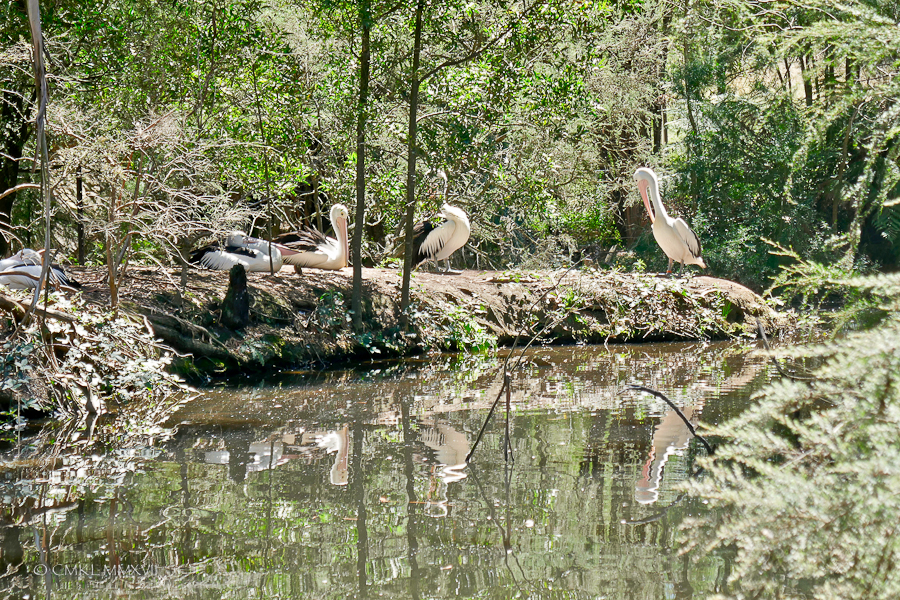

As long as we’re looking at birds, there was also a lovely green swamp-aviary, still and undisturbed but for feeding wading birds. The sharp contrast under the glaring sunlight created an almost two-dimensional feel of the scenery.
We saw mostly spoonbills, egrets, ducks, cormorants and one stork.
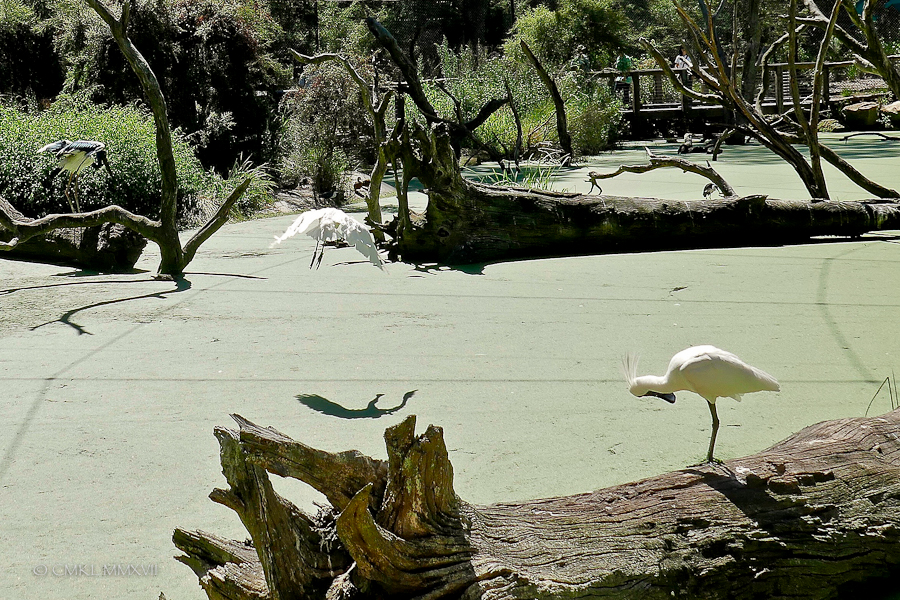

The highlight of my visit to the sanctuary was a Tasmanian devil, a living, breathing, healthy Tassie! Truth be told, I only saw the right side of [his or] her head for one minute and 41 seconds, but that was great. A living devil!
Walking by the Tassie enclosure, I didn’t expect to see any animals because they’re nocturnal, but this one, firmly believing in the importance of increasing her vitamin D metabolism, was sunbathing. Only a flash of red alerted me to the sleeping devil.

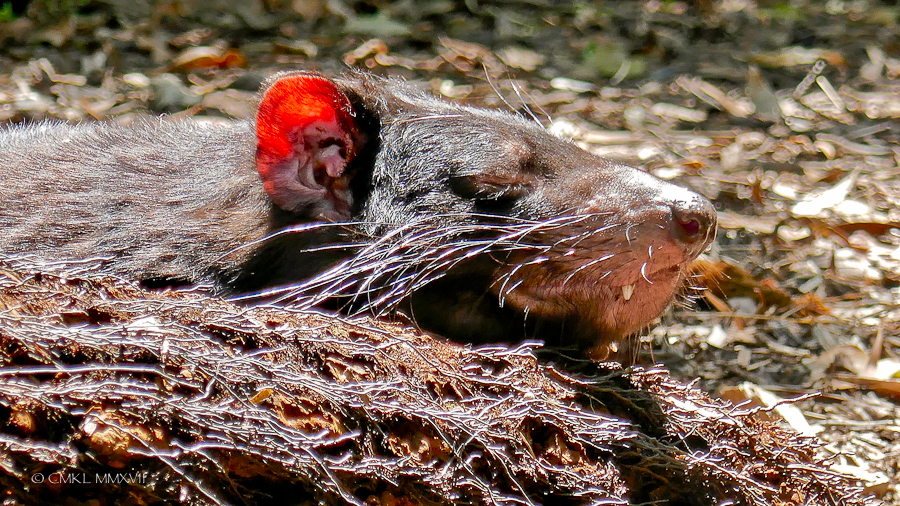

My presence was soon detected and after a luxurious stretch, my devil disappeared behind the log.

The Tasmanian devil, Sarcophilus harrisii, Dasyuridae, is the largest extant carnivorous marsupial. But it may not survive for much longer. The Devil Facial Tumor Disease, a contagious cancer, has so far defeated all efforts of containment or treatment and it is still 100% lethal. Conservation programs by governmental agencies and private organizations hope to maintain breeding efforts with diverse gene pools of healthy specimen to eventually re-introduce the Tasmanian devils into their natural habitat. Cross your fingers for the Tassies!
Lastly, our excursion to the sanctuary brought us face to face with the Australian dingo, Canis lupus dingo, Canidae. We didn’t see any dingo action or movement, just one animal resting against a far fence and another one with a chew-toy (?) under a rock shelter. See for yourselves:
Was that really a dingo? I didn’t think so! Even though pure-blooded dingos have become a rarety across Australia, this fuzzy white fluffball livestock guardian lookalike couldn’t possibly be a dingo. Back home, I googled a bit and found the story of Maliki & Dante ☺️
















![Home.Exchange.Melbourne.Healesville.Sanctuary Human leg[ging]s are fascinating as well!](https://i0.wp.com/photoleraclaudinha.com/wp-content/uploads/2017/03/melbourne-418-1140413.jpg?w=595&h=397&ssl=1)









Wonderful insights-and sights- of Australia. Extremely interesting.
LikeLike
It was fabulous! And so is your post!!
LikeLike